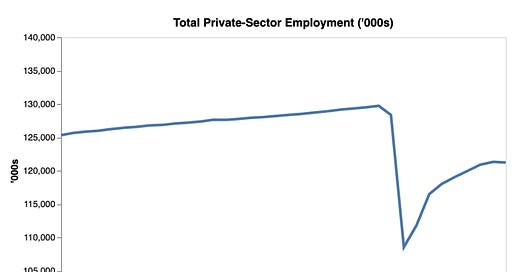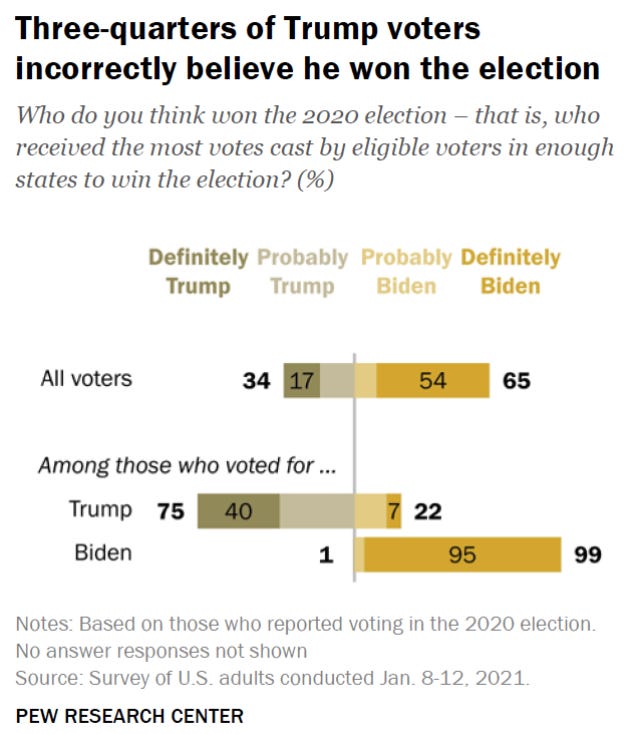A Widening Gap
Technology, media, and government helped cause this. It's on all of them (and us) to change the trajectory.
Welcome to issue #29 of next big thing.
It was quite a first month of 2021. Through major events such as the Georgia elections handing Democrats control of the U.S. Senate, the insurrection at the U.S. Capitol, the suspension of the U.S. President on Facebook and Twitter, the impeachment of the President, the rise (and banning) of new media platforms such as Parler, the run up in the price of Bitcoin, the inauguration of a new President, the GameStop saga in the public markets, distribution of covid-19 vaccines, and the death of nearly 100,000 people already this year in the U.S. due to the virus, there has been one theme I’ve kept coming back to as I try to make sense of everything:
A widening gap. A gap between the “haves” and the “have nots,” between those with disposable income and those that don’t have jobs. A gap between fact and fiction, between those that have access to the truth and those that are fed lies non-stop. A gap that’s been exacerbated by the pandemic, certainly, but also by the forces of technology, media, and politics, not just in the last four years, but for the past decade.
It will take considerable work, across technology, media, and government, to reverse this course. There isn’t a simple solution that will be the next big thing in 2021; instead, it’s going to take years of effort.
The good news for entrepreneurs is that there are many opportunities to build new products and services that can narrow the widening gap. I’ll touch on a few of those opportunities in this piece, but this is a theme I’m sure I’ll come back to many times in the years ahead.
Data On The Widening Gap
To better understand the current picture, let’s take a look at the data. Beyond combing through FRED, which is a great economic data resource, there were a couple of good analyses published in January about what happened in the economy over the past year.
Why Markets Boomed in a Year of Human Misery in The New York Times offers a simple breakdown of the U.S. economy at the end of 2020. Personal income increased in 2020 as a result of unemployment benefits, stimulus checks, and the wages lost being those from the lowest-paying jobs. Spending decreased in 2020 as a result of far less travel, in-person events, and other services. With income and spending going in opposite directions, as well as other factors such as interest rates being near zero and a dramatic surge in the money supply, Americans’ savings increased in 2020, leading to more investment in stocks and real estate, for example. This, in turn, has driven up the prices of financial assets across the board.
My friend Laura Yao compiled over a dozen charts of data that highlight the above points and more. Here are two examples from her piece:
Private sector employment fell significantly in April, and hasn’t recovered fully. Twenty million jobs were lost at the peak of the crisis. Seven million still have not been regained.
Overall, due to the increases in personal income and the decreases in outlays, the personal savings rate spiked up, and is still abnormally high compared to pretty stable pre-pandemic savings rates.
In addition to the widening economic gap that is plain to see in the data, particularly given the unnatural spikes in 2020, there are widening gaps in other parts of our society as well. I’m not suggesting that these gaps are entirely correlated, or that it’s the same people on either side of other growing divides. But it does feel like everywhere you look there’s a widening gap, and another obvious one is at the intersections of politics and (mis)information.
A Pew Research Center study a few weeks ago, which surveyed over 5000 U.S. adults following the riot at the U.S. Capitol, had some stunning findings. 64% of people who identified themselves as Republicans or leaning Republican said that Trump definitely/probably won the 2020 U.S. presidential election. This assertion has been disproved in numerous court decisions, rejected by Congress, and is just not true. Yet nearly two-thirds of Republican and Republican-leaning adults in this survey believe it to be true. Furthermore, 75% of voters who voted for Trump believe that he definitely or probably won the election – see the chart below.
Again, the data in the above survey was after the events at the U.S. Capitol on January 6. The entire study is worth reading, and is as fascinating as it is depressing. To reiterate the obvious, we are living in an extremely divided country, and the gap, on multiple dimensions, feels like it keeps getting bigger.
How Did We Get Here?
Before we can look forward, it’s important to reflect briefly on how this happened. By all measures, economic inequality has steadily grown in the U.S. over the past 50 years, and particularly in the past 11 years, since the Great Recession.
Fiscal and monetary policy has certainly contributed to this, with upper bracket tax rate decreases and record-low interest rates leading to more income for the wealthy, and increases in asset prices. This has further led to increases in net worth for those with assets, which certainly skews towards those with higher incomes — i.e. the “haves.” The safety net for those in the bottom quintile of incomes — the “have nots” —hasn’t gotten much better, if at all. Our politics have become more partisan, with the extremes on both sides of the aisle becoming more extreme and feeding disinformation, further widening the gap.
Disinformation has not been combatted effectively by the media, which has further exacerbated inequality. While many Americans still get their news from television, much of which is increasingly partisan, the rise of social platforms as a source of news has unfortunately led to the reinforcement of echo chambers of information and misinformation.
This brings us back to technology. My belief is that technology has leveled the playing field in so many ways — by democratizing access to many products and services, by increasing the availability of knowledge and information, and by increasing economic opportunity. But we must acknowledge that technology has played a significant role in deepening the divide we now find ourselves in as a society. From the algorithms that reward sensationalism over truth, to the performatory social platforms that encourage people to show their best selves instead of their real selves, technology has increased loneliness for many, led to the loss of certain types of jobs, and helped contribute to a widening gap.
With the pandemic as further fuel on the fire, we find ourselves in this unique moment in history, with inequality across many dimensions perhaps more noticeable and worrying than ever.
How Do We Course-Correct?
Narrowing this gap is going to take work on the part of all of us.
In government, I hope to see more experiments around universal basic income, increasing the minimum wage, and better safety nets for those at the bottom of the pyramid. There are so many jobs to be created as we transition away from fossil fuels to a clean economy ,and we need government initiatives that actually address the climate crisis. Education has gotten far too expensive for too many people, and this is another area in which federal, state, and local governments can work to improve access, particularly to educational programs and training that lead to good-paying jobs. And, perhaps most importantly, we need programs and incentives that enable everyday people to participate in the economic upside that is currently reserved for only the top people on the ladder who have access and an understanding of that upside. One example of an interesting idea to facilitate this, which I first heard about from investor Brad Gerstner, is an investment account that every child gets as birth but can only withdraw much later in life:

We need more creative thinking along these lines. Our world of technology can, should, and must play a major role in shaping a better and more equal future. And while some ideas will require government and policy to implement, there are others that we can get going on today, and are best suited to entrepreneurship.
We need new social platforms, ones that make people feel less lonely, where consumers aren’t “the product,” that enable folks to speak their minds, but also separate fact from fiction. Technology entrepreneurs can build them.
We need to lower our carbon footprint, reduce emissions, electrify everything, and extract carbon from the atmosphere. Technology entrepreneurs can build the products and services that help us do so.
Healthcare needs to be delivered with quality, convenience, and affordability to everyone. Education must be reinvented for the 21st century and the demands of today’s economy. Financial services must serve the consumer first, regardless of who they are or where they’re from. Food, housing, and basic necessities are still out of reach for far too many people. We need more platforms that enable entrepreneurship and economic opportunity for more people. And, while we’re at it, let’s pay attention to racial injustice and gender equality, to make sure the platforms we’re building making society more fair. Entrepreneurship will be a huge part of the solution to all of this.
If you’re building the future along any of these lines, please comment or reach out. The widening gap is a theme I’ll spend time working on in 2021, and in the years to come.
A big thank you to all of you who reached out asking when I would be writing something next. I’ve struggled to find the right words and the time to publish over the past month, but your encouragement has made me try harder. I hope that this piece helps get me back into the rhythm of writing every week.
I started next big thing to share unfiltered thoughts. I’d love your feedback, questions, and comments!
👇🏽 please hit the ♥️ button below if you enjoyed this post.







The sectors you mentioned, healthcare, education and housing, also suffer from cost disease. While the productivity should have grown, since the emergence of tech has made all of these sectors more productive, practically they remain highly expensive! I looked into this quite a bit in my substack, and it remains a pretty interesting mystery, and probably the central one for us today.
While tech will help us move forward, it has to be said that so far the hunt for efficiencies have helped, but haven't solved for the heavy polarisation that we see - both economically and socio-politically. That remains not just a technocratic challenge, but a deeper social and political one.
I really loved this post. I think this is the ultimate goal of what we should be aiming to with our job as investors. I think that what you write here should be a manifesto across all the VC market. Narrowing the gap of inequality would be the best use of technology, talent, and capital together. I don't know how I can help, but I would happy to contribute to the discussion.